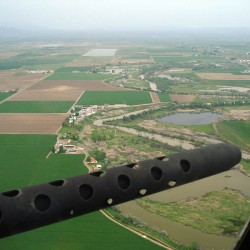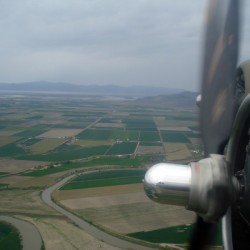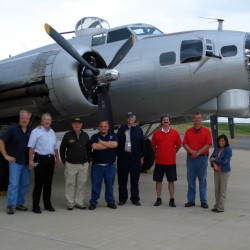Flying Fortress takes passengers back to WWII
June 8th, 2010 Posted in Arts and LifeStory and Photos by Caresa Alexander
SOMEWHERE ABOVE CACHE VALLEY—The vintage World War II bomber roared along the runway the Logan Cache Airport as spectators waved. Sitting in the waist section of the plane, five of us grinned in anticipation.
Inside the B-17G Flying Fortress “Aluminum Overcast” the engine noise was so loud we had to shout to hear each other. The plane shook as the more than 34,000-pound bomber ascended into the sky.
than 34,000-pound bomber ascended into the sky.
Bill Hooton, a crewmember for the Experimental Aircraft Association (EAA)—a national organization for plane lovers—gave instructions before we boarded. There were six exits, which we hoped not to need until we landed. As soon as we were airborne, we would be given the thumbs-up to move around the plane. Two people could be in the nose of the aircraft at a time. As the thumbs-up came, we all unbuckled our seat belts. The three other passengers who were sitting in the radio room came aft to stare out the larger windows.
 The “Aluminum Overcast” climbed and lazily curved west over the Wellsville mountains toward Tremonton. Donated in the 1980s to the Wisconsin-based EAA, the venerable bomber’s restoration took 10 years; now the B-17 tours the country as a historic artifact (see http://www.b17.org/). Although more than 65 years old, the aircraft seemed to climb effortlessly over the mountains. Below, the Bear River meandered through green Cache Valley fields.
The “Aluminum Overcast” climbed and lazily curved west over the Wellsville mountains toward Tremonton. Donated in the 1980s to the Wisconsin-based EAA, the venerable bomber’s restoration took 10 years; now the B-17 tours the country as a historic artifact (see http://www.b17.org/). Although more than 65 years old, the aircraft seemed to climb effortlessly over the mountains. Below, the Bear River meandered through green Cache Valley fields.
Maneuvering around inside the plane was a little difficult since the aircraft was narrow. Over the bomb bays, only one person at a time could shuffle sideways across the catwalk to get to the cockpit. John Hambleton of Logan joked that if he ever needed more incentive to lose 100 pounds, then trying to squeeze through the opening was it.
Some passengers took turns as waist gunners, pretending they were in combat and  firing at the enemy, although this plane never saw battle during WWII. The “Aluminum Overcast” was restored and put on tour with the EAA in 1994, said 20-year EAA member Michael Degangi. The EAA had to find all the military equipment such as the turrets and the guns to rebuild the bomber (http://www.eaa.org/news/2006/2006-03-07_b17.asp).
firing at the enemy, although this plane never saw battle during WWII. The “Aluminum Overcast” was restored and put on tour with the EAA in 1994, said 20-year EAA member Michael Degangi. The EAA had to find all the military equipment such as the turrets and the guns to rebuild the bomber (http://www.eaa.org/news/2006/2006-03-07_b17.asp).
The best view was from the nose. On hands and knees, I crawled into the bombardier space, took a seat in the Plexiglas nose and looked below. Underneath my feet was Box Elder County. To my sides were four 1,200 horse-powered engines and wings that spanned 103 feet, 9 inches. In front of me lay the snow-capped Wasatch Mountains surrounded by grey storm clouds.
I cautiously made my way up to the cockpit and stood behind the pilots. The instrument panel was filled with throttles, dials and gauges. A wave of gratitude swept over me as I thought of those pilots who years before sat in that same position in wartime. The pilots skillfully handled the aircraft as we made our way toward the Ogden-Hinckley Airport and the passengers returned to their seats.
As we started our descent, I looked out the window from where I sat in the radio room. The wing dipped toward the ground and I could see subdivisions, church buildings and road signs. The wheels hit the runway smoothly and we rolled to a stop. All too quickly our flight was over.
The smiles remained on our faces as we stepped out of the plane. Each had a favorite part of the ride to share.
 Hambleton, who is majoring in aviation maintenance and management at Utah State University, was impressed with the landing. “The pilot was obviously very skilled,” he said. “He was cutting it close and it was a perfect landing. I was really impressed. I didn’t think he could make that tight of a turn and he just did it.”
Hambleton, who is majoring in aviation maintenance and management at Utah State University, was impressed with the landing. “The pilot was obviously very skilled,” he said. “He was cutting it close and it was a perfect landing. I was really impressed. I didn’t think he could make that tight of a turn and he just did it.”
Lan Turner, president and CEO of Gecko Software, Inc., in Providence is a pilot. He said the flight was probably about 1,500 feet above the ground.
“My favorite part of the ride was being there with all my friends,” Turner said. “Some of the people on that flight are the best friends a man could ever hope to have, and to share that opportunity with good friends, to smile, laugh, take photos and be able to ride in an airplane with such a great aviation history was a huge thrill. Sharing experiences like that, with friends, is what life’s all about for me.”
As we took pictures by the plane, the flight on the historic World War II bomber remained in our mind and hearts. I thought of my grandpa and perhaps other groups of friends who had served in the war together. They truly were examples of “the greatest generation.”
TP

Sorry, comments for this entry are closed at this time.